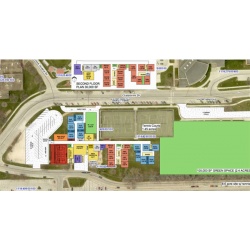
Paul Scott comment: What is "set in stone" for new elementary school?
(The following is a comment by decorahnews.com's Paul Scott):
"I love a good question. And about a month ago at a City of Decorah committee meeting, city council member Gary Rustad asked a very good question about the Decorah School Board's request to buy the city softball diamond to build a new elementary school: "Is it set in stone that those tennis courts have to stay there?" He then added, "It would be easier to relocate those tennis courts than it would to find land for a softball field."
What a great question! Gary could have pointed out as well that it would be cheaper to relocate tennis courts than it would be to buy land and pay to develop two new softball fields—according to some estimates, $300,000 for new tennis courts, as opposed to $1.2 million for a new softball complex with two fields.
It might also produce a better building design to relocate the tennis courts instead of the softball field. If you haven't seen the preliminary architectural sketch for the proposed elementary school, we're posting it with this comment. The first thing you'll notice is the extent to which the architects have had to work around the tennis courts. It's not the best design, but when you start with the assumption you'll be keeping the tennis courts, it's the one you're stuck with.
So we're back to Gary Rustad's question, "Is it set in stone that those tennis courts have to stay there?" I'd suggest that it makes a lot more sense to tear out the tennis courts instead of the softball diamond.
But I'd like to revisit the larger question once again, "Is it set in stone that the elementary school has to be downtown?" Here are some of the disadvantages I see once you say "yes" to that question:
--It uses a smaller parcel of land, which limits future expansion. If the school board is truly "designing a school for the next 50 years," it would be better to be locating that building on enough land to allow for future expansion or changes. A much bigger plot of land for school purposes—whether property at the Highway 9 & 52 intersection, or property near Vennehjem or property just north of Decorah on Highway 52, would have anywhere from 9 to 20 acres--or more.
--It forces architects to adapt to existing development, whether tennis courts or softball diamonds or streets, rather than starting with a clean drawing board to design the best elementary school possible.
--It continues to place young children in an area in which 16-year-old boys are learning how to drive! By contrast, a different location would reduce the risk of a first or second-grader getting hit by a car.
--It does nothing about traffic congestion on Claiborne Drive. This area not only has teenagers speeding out of the high school parking areas, it has parents waiting to drop off or pick up kids at John Cline. In addition, the line of parents waiting in their cars to pick up elementary school students in the afternoon creates bottlenecks that will only get worse—especially if the school is built on the softball diamond, near the Post Office and City Hall
--It takes away options of preserving City of Decorah property for future use. If the school board is "designing a school for the next 50 years," shouldn't the Decorah City Council also be "designing a downtown area for the next 50 years?"
It's interesting to me that when Gary Rustad asked his question at the recent city committee meeting, he used the phrase "set in stone." He not only asked a good question, but picked a good phrase to describe the process so far--"set in stone." The school board keeps saying to people, "Here's what we want." They're doing their job when they do this—but it's the job of the public to weigh in on the assumptions that have produced the school board's recommendations.
So here's the overall question that has to be answered before the Decorah City Council can decide whether selling the softball diamond to the Decorah School District is the right move to make: "Is it set in stone that the elementary school has to be downtown?" Contact a Decorah City Council or Decorah School Board member with your answer—whatever it is. And thank Gary Rustad when you see him.
Site designed and maintained by Iroc Web Design Services©.
Your Small Business Web Design Solutions.™


